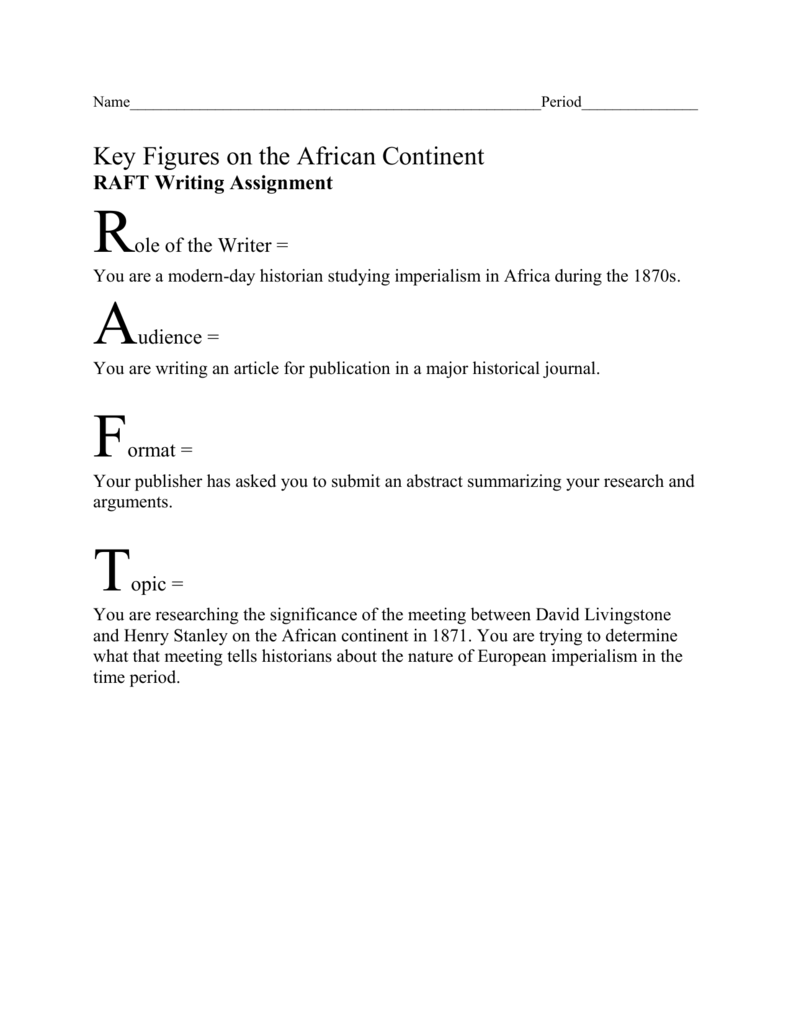
Begin by explaining the RAFT writing system to students. RAFT is a system for making sure students understand their role as writer, their audience, the format of their work, and the expected content of their writing. These key ingredients are included in every RAFT writing assignment: Role of a writer: You must decide who (or what) you will be Decide who the audience would be as well as the format for writing. After students have finished the reading, identify the role, audience, format and topic (RAFT) for the writing assignment. Assign the same role for all students, or let them choose from several different roles RAFT assignments encourage students to uncover their own voices and formats for presenting their ideas about content information they are studying. Students learn to respond to writing prompts that require them to think about various perspectives: Role of the Writer: Who are you as the writer? A movie star? The President? A plant?
Using the RAFT Writing Strategy - ReadWriteThink
The RAFT strategy employs writing-to-learn activities to enhance understanding of informational text. Rather than write a traditional essay to explain a concept, students demonstrate their raft writing assignment in a nontraditional format.
This technique encourages creative thinking and motivates students to reflect in unusual ways about concepts they have read. The RAFT strategy encourages students to process information, rather than merely prepare answers to questions.
Varied prompts allow students to compare and contrast multiple perspectives, deepening their understanding of the content when shared. Students are more motivated to undertake the writing assignment because it can be customized to fit different learning styles. RAFT: Role, Audience, raft writing assignment, Format, Topic. Item description:. RAFT is an acronym that stands for: Â Role of the writer: What is the writer's role: reporter, observer, raft writing assignment, eyewitness, object, number, etc.?
Audience : Who will be reading the writing: the teacher, other students, a parent, editor, people in the community, raft writing assignment Format : What is the best way to present this writing: in a letter, an article, a report, a poem, raft writing assignment advertisement, email, etc.?
Topic : Who or what is the subject of this writing: a famous scientist, a prehistoric cave dweller, a character from literature, a chemical element or physical object, etc.?  The RAFT strategy encourages students to process information, rather than merely prepare answers to questions. Implementation  Decide on an area of study currently taking place in your classroom for which you could collaborate with the students and write a class RAFT. Think about the concepts or process skills that you want students to learn as they read a selected passage.
Imagine how writing in a fun way may enhance students' understanding of the topic or concept. Brainstorm possible roles students could assume in their writing. Decide who the audience would be as well as the format for writing. After students have finished the reading, raft writing assignment, identify the role, audience, format and topic RAFT for the writing assignment. Assign the same role for all students, or let them choose from several different roles.
 Classroom Management Describe the various perspectives that writers must consider when completing any writing assignment. Have a class think-aloud to come up with ideas for the piece of writing that you will create as a group. Review the basic content of the reading, but allow students to select the role, audience, format, and topic to write about. Model how you would write in response to the prompt, raft writing assignment. Allow student input and creativity as you craft your piece of writing.
Give students another writing prompt for which you have already chosen the role, audience, format, and topic and have students react to the prompt either individually or raft writing assignment small groups.
It works best when all students follow the same process so that they can learn from the varied responses of their classmates. Choose a few students to read their RAFT raft writing assignment. Discuss how each student created their own version of the RAFT while using the same role, raft writing assignment, audience, format, and topic.
As students become comfortable reacting to RAFT prompts, give them a list of options for each component and let them choose their role, audience, format, and topic. Eventually, students can be allowed to identify their own role, audience, format, and topic. Attachment Size 6mlfwrfrbjgowk. doc 77 KB. References Contributors:.
RAFT Writing Strategy (JHAT, Jr.)
, time: 2:38RAFT | Classroom Strategies | Reading Rockets

RAFT assignments are tailor-made for sharing among students in small groups or for inclusion in a collection of student writing about topics within a study unit that can be shared with the entire class. RAFT activities involve students in visualizing, determining importance of information, making inferences, and synthesizing RAFT assignments encourage students to uncover their own voices and formats for presenting their ideas about content information they are studying. Students learn to respond to writing prompts that require them to think about various perspectives: Role of the Writer: Who are you as the writer? A movie star? The President? A plant? RAFT is a writing strategy that helps students understand their roles as writers, the audience they will address, the varied formats for writing, and the topic they'll be writing about. By using this strategy, teachers encourage students to write creatively, to consider a topic from a different perspective, and to gain practice writing for different audiences

No comments:
Post a Comment